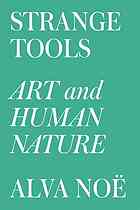
Strange Tools
Art and Human Nature
کتاب های مرتبط
- اطلاعات
- نقد و بررسی
- دیدگاه کاربران
نقد و بررسی

June 29, 2015
Noë (Out of Our Heads), a philosopher specializing in perception and consciousness, explores aesthetics from an unlikely starting point: activities like breastfeeding, reading a sign on a wall, driving a car, opening a door, or conversing with a friend. We “lose ourselves in the flow” of these “organized activities,” as he calls them—an expression of our biological and existential condition. But the myriad activities that organize and constantly reorganize our lives are difficult to untangle, and as Noë gets caught up in them, the reader gets lost. Art, like philosophy, the author argues, “is a practice for bringing our organization into view.” Noë explores this conceit through a range of topics as they relate to art, such as the importance of boredom, the role of criticism, and the impossibility of neuroscience explaining art, with analogies from baseball to barkeeping, and help from the work of philosophers such as Plato, Immanuel Kant, and John Dewey. In relating complex problems in perception and consciousness, which have long filled pages in philosophy journals, Noë mostly forgoes jargon and citations in favor of mercifully plainer prose. Still, the book meanders through a lot of conceptual ground despite tilting toward the visual arts—Western and modern at that—and away from music, film, poetry, and fiction. Agent: John Brockman.

May 15, 2015
Art as communication, transaction, and philosophy. In a stimulating and wide-ranging investigation of the meaning of art, Noe (Philosophy/Univ. of California; Varieties of Presence, 2012, etc.) acknowledges the complexity of his questions: "What is Art? Why does it matter to us? What does it tell us about ourselves?" The author likens art to philosophy: both are practices that ask us to examine how we organize ourselves and open up the possibility for reorganization. Art, he writes, "investigates or exposes by destabilizing." Like John Dewey, whose Art as Experience (1934) he repeatedly evokes, Noe believes that the "aesthetic attitude is thoughtful and inquiring...natural and universal." The author is skeptical of both evolutionary and neuroscientific perspectives that posit biological or materialist theories about art, both of which he sees as reductionist. Evolutionary theories, Noe argues, "tend to be empty. They don't tell us why we make art or why art is valuable for us. They don't bring the art in art into focus." As a researcher and member of the Institute for Cognitive and Brain Sciences at the University of California, he feels "skeptical of the prospects for an empirical neuroscience of art," since responses to art are never merely emotional but rather "more like judgments...shaped by our knowledge and background and experience and the larger culture and shared attitudes." Noe sees technology as the precondition of art. Humans "are designers by nature" for whom technology extends into language and picture making. Writing enables communication but also shapes thought. Pictures, too, "are moves or gestures in a familiar communication game," but Noe distinguishes between functional design and art, which provokes because it is strange and subversive. Every work of art-including music, dance, and the visual arts-"propositions you to see it, to comprehend it...to reorganize, and also to catch yourself in the act." A searching and learned response to vexing, long-debated questions.
COPYRIGHT(2015) Kirkus Reviews, ALL RIGHTS RESERVED.

June 1, 2015
Noe (philosophy, Univ. of California, Berkeley; Out of Our Heads) aims to show the similarities between art and philosophy in their ability to organize our experiences into ways of understanding human life. The "strange tools" from the title refer to works of art. Noe's focus isn't on pieces of expression as objects but instead on the experience of making art. Art's strangeness is that it puts the creator's experience on display. While this feature of art might make it difficult to see how it's similar to philosophy, Noe explains that both subjects share the same goals of "self-transformation and achievement of understanding" and use similar human faculties in accomplishing these goals. This is an important point for Noe. Just like philosophy, art "isn't a phenomenon to be explained." Instead, it's an activity that we use to demonstrate, in much the same way philosophy helps elucidate, the human condition. VERDICT Noe offers a unique analysis on the role of art, and also philosophy, in our lives. Readers with an interest in philosophy, aesthetics, or art will find this an accessible and engaging read.--Scott Duimstra, Capital Area Dist. Lib., Lansing, MI
Copyright 2015 Library Journal, LLC Used with permission.

























دیدگاه کاربران